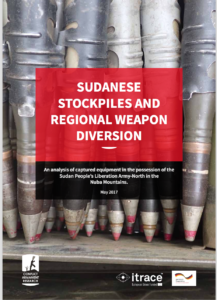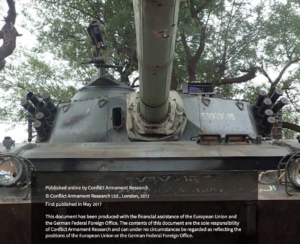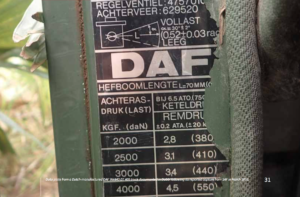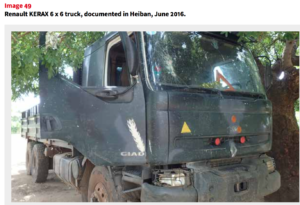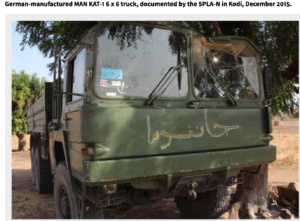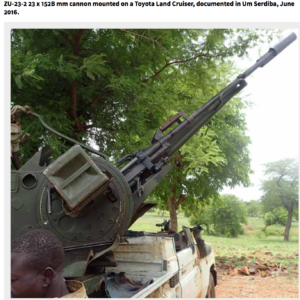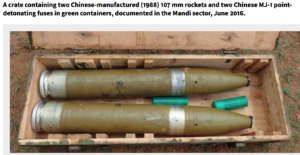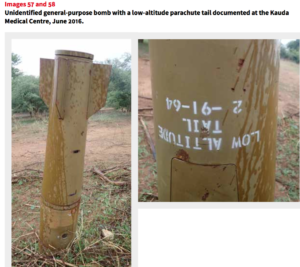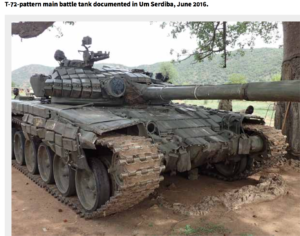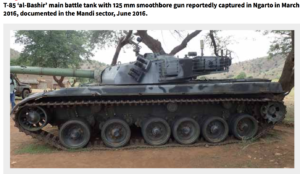The Khartoum Regime Continues to Import Large Quantities of Weapons and Dual-Use Equipment from a Range of International Actors
Eric Reeves | June 1, 2017 | http://wp.me/s45rOG-7902
A new report from Conflict Arms Research makes clear that the Khartoum regime continues to import large quantities of weapons in order to continue offensive military action in South Kordofan, Blue Nile, and Darfur. The weapons come from “East Asia, the Middle East, and Europe.” This makes nonsense of the regime’s commitment to end offensive military activity in these areas, one of two key terms for permanent lifting of U.S. economic sanctions (a decision to be made by the Trump administration by July 13, 2017).
To ignore such authoritative findings in assessing NIF/NCP genocidal tyranny was a hallmark of U.S. Sudan policy under the Obama administration—and a rudderless Trump administration is likely to make a decision by default to lift sanctions permanently (the administration has no Assistant Secretary of State for African Affairs unless that task, too, has fallen to Trump’s son-in-law Jared Kushner).
*************************************************
“Sudanese Stockpiles and Regions Weapon Diversion,” a report from Conflict Arms Research (May 2017)
An analysis of captured equipment in the possession of the Sudan People’s Liberation Army-North in the
Nuba Mountains.
EXECUTIVE SUMMARY
For more than half a decade, Sudan has waged a war of attrition against the Sudan People’s Liberation Army-North (SPLA-N) in South Kordofan’s isolated Nuba Mountains region and the southeastern border state of Blue Nile. Despite the Sudan Armed Forces’ (SAF) military superiority in terms of logistics, air power, and heavy weaponry, government-aligned forces have failed to dislodge the SPLA-N from the areas it controls.
For its part, the SPLA-N has been unable to capture key SAF garrison towns. The military stalemate on the battlefield has contributed to an impasse in negotiations led by the African Union (AU).
In June 2016, Conflict Armament Research (CAR) examined a range of weapons, ammunition, vehicles, and other military and dual-purpose equipment captured from SAF and its affiliated militias by the SPLA-N in the Nuba Mountains.
Despite the imposition of a European Union (EU) arms embargo on Sudan since 1994 and a UN arms embargo on the Sudanese state of Darfur since 2005, CAR’s findings suggest that the Sudanese government continues to benefit from relatively unrestricted access to military imports. These imports have been supplemented by the acquisition of non-military or dual-purpose equipment from East Asia, the Middle East, and Europe.
[Note the necessary disclaimer in this photograph: the German government and EU are supplying dual-use (military and civilian use) equipment to the Khartoum regime, a fact they would rather keep quiet—ER]
THE ANALYSIS OF CAPTURED WEAPONS AND AMMUNITION CONTAINED IN THIS REPORT PROVIDES A GLIMPSE INTO SUDANESE WEAPON STOCKPILES, SUPPLY LINES, AND SOURCES OF EXTERNAL SUPPORT.
While Sudan continues to import heavy weaponry, mainly from China and the Russian Federation, it has also invested in its own domestic military production and assembly capabilities, which have expanded significantly over the last decade.
CAR’s findings also suggest that Sudan continues to supply arms to state and non-state armed groups across the East African region and the western Sahel. Since 2014, CAR and its investigative partners have documented newly manufactured Sudanese military materiel captured from non-state armed groups in South Sudan, the Central African Republic, Côte d’Ivoire, Libya, Mali, and Niger.
IN A NUMBER OF CASES, SUDAN APPEARS TO HAVE REPACKAGED AMMUNITION OR OTHERWISE MASKED SHIPPING INFORMATION APPLIED TO AMMUNITION BOXES IN ORDER TO CONCEAL ITS PROVENANCE.
The newness and condition of some of this materiel, in addition to testimonies and contextual evidence provided to CAR, suggest that Sudan has supplied it directly to non-state groups—at least during the period 2014–15.
In a number of cases, Sudan appears to have repackaged ammunition or otherwise masked shipping information applied to ammunition boxes in order to conceal its provenance. This is notably the case for large quantities of Chinese ammunition. One probable reason for this is Sudan’s attempts to disguise its retransfer of Chinese-supplied ammunition to non-state groups beyond its borders, which would constitute a clear violation of its end-user agreements—and specifically their non-retransfer clauses—with the Chinese government.
The analysis of captured weapons and ammunition contained in this report provides a glimpse into Sudanese weapon stockpiles, supply lines, and sources of external support. These findings provide a significant measure of the effectiveness and impact of arms embargo restrictions, and highlight the continued efforts on the part of the Sudanese government to conceal violations of end-user agreements made with supplier states and its support for non-state armed groups.
CAR bases its findings exclusively on materiel documented in the field and supported by contextual interviews with those in possession of the materiel at the time of documentation. CAR never bases its findings on reports or images presented on social media, due to the difficulties of verifying the provenance of the reports or the materiel depicted in them.
KEY FINDINGS
• Despite international pressure to end the conflicts in South Kordofan and Blue Nile, SAF has little difficulty in acquiring weapons and ammunition of recent manufacture (both domestically manufactured and imported) and deploying them in the South Kordofan theatre. While the composition of SAF stockpiles has remained relatively consistent in recent years, CAR notes recent additions to SAF’s arsenal, including commercially available Chinese unmanned aerial vehicles (UAVs) or drones, a T-85 main battle tank, and a Chinese- manufactured anti-materiel rifle. Sudan continues to rely on imported military technology from several foreign countries, most notably China, to expand the production and assembly capabilities of its state-owned Military Industry Corporation (MIC).
Data plate from a Dutch-manufactured DAF YA4440 DT 405 truck documented in Dabbi following its reported capture from SAF in March 2016.
• With the valuable assistance of the Dutch government, CAR has determined that SAF continues to procure military and dual-purpose transport vehicles of European manufacture, exported in particular from the Netherlands.
• In response to CAR and investigative partners reporting Sudan’s military use of these vehicles, the Dutch government has revised its export rules to better control exports of heavy logistics vehicles. However, these revised rules do not cover some of the Dutch-manufactured heavy vehicles that SAF has procured and deployed in South Kordofan.
• Sudan continues to benefit from relatively unrestricted access to military imports, as well as to dual-purpose and civilian equipment, which it routinely repurposes for military use. This includes Chinese commercial UAVs and European-manufactured dual-purpose transport vehicles—supplies of which are arguably less vulnerable to external diplomatic pressure than exclusively military commodities.
KEY FINDINGS
• With the assistance of the Toyota Motor Corporation, CAR has identified four private distributors in the Middle East that have bulk purchased almost all of the Toyota Land Cruisers documented in use by SAF since 2009. CAR does not suggest any wrongdoing on the part of these distributors or implies that they supplied vehicles directly to SAF. However, the fact that supplies of Land Cruisers to SAF originate from such a small group of distributors indicates the potential ease with which due-diligence procedures might be enforced to address Sudan’s diversion of commercial vehicles to military uses.
[Toyota Land Cruisers are the vehicle of choice for all sides in the conflict–ER]
• Despite longstanding US sanctions on Sudan (only recently and partially lifted), the purchaser of at least one SAF vehicle documented on the South Kordofan battlefield is a US citizen. The person concerned purchased the vehicle from a Gulf State distributor more than three years prior to the current investigations. CAR continues to investigate the vehicle’s onward transfer to SAF.
• Sudan continues to conceal the origins of foreign-made ammunition. It does so primarily by repackaging newly produced Chinese ammunition into Sudanese-manufactured ammunition boxes. This must be viewed in light of Sudan’s continued violation of its end- user obligations—particularly non-retransfer clauses—to the Chinese government. This trend is further evidenced by CAR’s documentation of large quantities of newly produced Chinese ammunition captured from the Sudan People’s Liberation Army in Opposition (SPLA-iO) in South Sudan.
• CAR also documented 1970s-era Soviet- manufactured small arms ammunition repackaged in cartons consistent with Ethiopian industry standards.
• The weapon types and lot/serial number sequences of captured SAF materiel documented in the Nuba Mountains correlates with weapons and ammunition captured from non-state armed groups in the Central African Republic, Côte d’Ivoire, Libya, Mali, and Niger. These correlations support allegations that Khartoum continues to divert weapons and ammunition to state and non-state forces across the northern half of the African continent.
[full report at | http://www.conflictarm.com/publications/ ]
Other photographs from the scores compiled by CAR:
[The medical center at Kauda was the target, as it has been on countless other occasions—ER]
[The military odds are heavily stacked against the Sudan People’s Liberation Army/Movement-North—but the people of the region know full well that they are fighting against a regime that is bent on their annihilation—ER]
